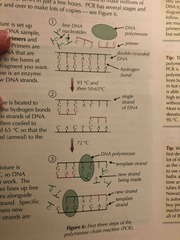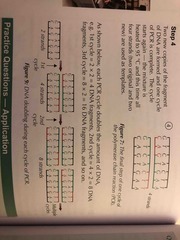![]()
![]()
![]()
Use LEFT and RIGHT arrow keys to navigate between flashcards;
Use UP and DOWN arrow keys to flip the card;
H to show hint;
A reads text to speech;
19 Cards in this Set
- Front
- Back
- 3rd side (hint)
|
One you’ve got a fragment of DNA, you’ll probably want to make more copies of it - this is called gene cloning. |
- |
|
|
|
What are the two techniques for gene cloning? |
• In vivo cloning • In vitro cloning |
|
|
|
What are the 3 parts to In vivo cloning? |
1. Making recombinant DNA 2. Transforming cells 3. Identifying transformed cells |
|
|
|
Describe how to do part 1 of In vivo cloning: making recombinant DNA? |
1. The vector DNA is isolated 2. The vector DNA is cut open using the same restriction endonuclease that was used to isolate the DNA fragment - this means that the sticky ends of the vector DNA are complementary to the sticky ends of the DNA fragment 3. The vector DNA and DNA fragment are mixed together + DNA ligase is added NB - DNA ligase joins the sticky ends of the fragment to the sticky ends of the vector DNA (process called Ligation) 4. The new DNA (vector DNA + DNA fragment) is called recombinant DNA |
|
|
|
Define – a vector? (in terms of gene technologies) |
Something that’s used to transfer DNA into a cell |
|
|
|
Give some examples of things that can be used as vectors? |
• plasmids (small, circular DNA molecules in bacteria) • bacteriophages (viruses that infect bacteria) |
|
|
|
Describe how to do part 2 of in vivo cloning: Transforming cells? |
If plasmid used as vector: • host cells are encouraged to take up the plasmid with recombinant DNA - transferring the gene into the cells • Bacteria can be encouraged to take up DNA by electroporation - given an electric shock, creates holes in the cell through which DNA pass If Bacteriophage used as vector: 1. bacteriophage infects the host bacterium by injecting its DNA into it 2. the phage DNA (with the target gene in it) integrates into the bacterial DNA NB - host cells that take up the vectors containing the target gene are said to be transformed |
|
|
|
What do you call a host cell that takes up a vector containing a target gene? |
A transformed cell |
|
|
|
Describe how to do step 3 of in vivo cloning: Identifying transformed cells? |
NB - only around 5% of host cells will take up the vector DNA, so it’s important to be able to identify which cells have been transformed - Marker genes are used 1. A marker gene can be inserted into vectors at the same time as the target gene - any transformed host cells will contain this marker gene 2. Host cells grown on agar plates, each cell divides and replicates its DNA, creating a colony of cloned cells 3. Either: • Agar can contain an antibiotic, the marker gene can code for antibiotic resistance, only transformed cells with the marker gene will survive and grow • Marker gene can code for fluorescence, when the agar plate is placed under UV light, only transformed cells will fluoresce 4. Identified transformed cells are allowed to grow more - producing lots of copies of the cloned gene |
|
|
|
Describe how to do step 3 of in vivo cloning: Identifying transformed cells? |
NB - only around 5% of host cells will take up the vector DNA, so it’s important to be able to identify which cells have been transformed - Marker genes are used 1. A marker gene can be inserted into vectors at the same time as the target gene - any transformed host cells will contain this marker gene 2. Host cells grown on agar plates, each cell divides and replicates its DNA, creating a colony of cloned cells 3. Either: • Agar can contain an antibiotic, the marker gene can code for antibiotic resistance, only transformed cells with the marker gene will survive and grow • Marker gene can code for fluorescence, when the agar plate is placed under UV light, only transformed cells will fluoresce 4. Identified transformed cells are allowed to grow more - producing lots of copies of the cloned gene |
|
|
|
There’s a final important step in in vivo cloning, if you want the transformed host cells to produce the protein coded for by the target gene. What is it? |
Make sure that the vector contains specific promoter and terminator regions Promoter regions - DNA sequences that tell the enzyme RNA polymerase where to start producing the mRNA Terminator regions - DNA sequences that tell the enzyme RNA polymerase where to stop producing mRNA |
|
|
|
There’s a final important step in in vivo cloning, if you want the transformed host cells to produce the protein coded for by the target gene. What is it? |
Make sure that the vector contains specific promoter and terminator regions Promoter regions - DNA sequences that tell the enzyme RNA polymerase where to start producing the mRNA Terminator regions - DNA sequences that tell the enzyme RNA polymerase where to stop producing mRNA |
|
|
|
There’s a final important step in in vivo cloning, if you want the transformed host cells to produce the protein coded for by the target gene. What is it? |
Make sure that the vector contains specific promoter and terminator regions • Promoter regions - DNA sequences that tell the enzyme RNA polymerase where to start producing the mRNA • Terminator regions - DNA sequences that tell the enzyme RNA polymerase where to stop producing mRNA Without the right promoter regions, the gene won’t be transcribed by the host cell and a protein won’t be made These regions may already be present in the vector DNA or may have to be added in |
|
|
|
How do you do in vitro cloning via the polymerase chain reaction (PCR) method? |
1. Reaction mixture set up, contains: the DNA sample, free nucleotides, primers, DNA polymerase 2. The DNA mixture is heated to 95° C -> breaks H-bonds between the two DNA strands 3. The mixture is cooled to 55°C so that the primers can bind (anneal) to the strands 4. Reaction mixture is heated to 72°C so that DNA polymerase can work - DNA polymerase lines up free DNA nucleotides alongside each template strand, CBP forms complimentary strands 5. 2 new copies of the DNA fragment are formed and one cycle of PCR is complete 6. The cycle starts again - the mixture is heated to 95°C, this time all four strands are used as templates, forming 4 fragments (See hint for picture) |

|
|
|
What are - Primers? |
Short pieces of DNA that are complimentary to the bases at the start of the fragment you want to copy |
|
|
|
In in vitro cloning, ‘the reaction mixture is heated to 72°C so that DNA polymerase can work.’ How is it not denatured? |
Use Taq polymerase - comes from bacteria in hot springs, able to withstand high temperatures |
|
|
|
Define- in vitro cloning? |
Gene copies are made outside of a living organism |
|
|
|
Define - in vivo cloning? |
Gene copies are made within a living organism -> as the organism grows and divides, it replicates the DNA, creating multiple copies of the gene |
|
|
|
Picture to help visualise the repeats of multiple PCR cycles |

Back (Definition) |
|

